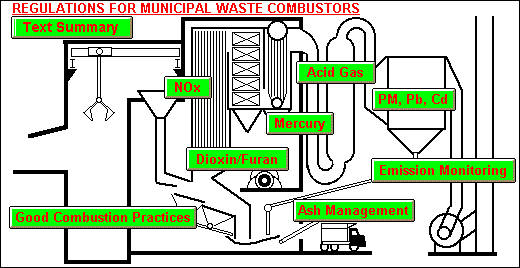|
REQUIREMENTS OF THE NEW SOURCE PERFORMANCE STANDARDS AND
EMISSIONS GUIDELINES AS AMENDED ARE:
(All emission levels are at 7% oxygen, dry basis)
1. GOOD COMBUSTION PRACTICES - NEW & EXISTING FACILITIES:
- Must not exceed 110% of the maximum load level demonstrated
during dioxin/furan performance tests.
- Temperature at inlet to PM control device cannot exceed by
more than 17 deg. C. the demonstrated temperature during
dioxin/furan performance tests.
- CO must not exceed 50 to 150 ppmv depending on type of unit
for new units, and 50 to 250 ppmv for existing units.
- Certification of chief facility operators and shift
supervisors, and training for plant operators.
- Continuous emissions monitoring of Sulfur Dioxide, NOx,
Opacity, CO, Load, and Temperature.
- Annual stack testing for Particulates, Lead, Cadmium,
Dioxins/Furans, and HCL.
- Opacity must be less than 10% (6-minute average)
2. PARTICULATE EMISSION LIMITS
| New Facilities |
24 mg/dscm (0.010 gr/dscf) |
| Existing Facilities >250 TPD |
27 mg/dscm (0.012 gr/dscf) |
| Existing Facilities <250 TPD |
70 mg/dscm (0.03 gr/dscf)* |
3. CADMIUM EMISSION LIMITS
| New Facilities |
.02 mg/dscm (8.7 gr/mil dscf) |
| Existing Facilities >250 TPD |
.04 mg/dscm (18gr/mil dscf) |
| Existing Facilities <250 TPD |
.10 mg/dscm (44gr/mil dscf)* |
4. LEAD EMISSION LIMITS
| New Facilities |
.20 mg/dscm (87 gr/mil dscf) |
| Existing Facilities >250 TPD |
.49 mg/dscm (200 gr/mil dscf) |
| Existing Facilities <250 TPD |
1.6 mg/dscm (700 gr/mil dscf)* |
5. MERCURY EMISSION LIMITS
| New & Existing Facilities |
.08 mg/dscm (35 gr/mil dscf)
OR an 85%
reduction |
6. ORGANIC EMISSION LIMITS
Dioxins and Furans are measured as total
tetra-through-octa-chlorinated dibenzo-p-dioxins and dibenzofurans.
Operators seeking less frequent testing may elect to meet lower
limits. The limits are:
| New Facilites |
13 ng/dscm (or 7 ng with less freq.
testing) |
| Existing Facilities >250 TPD |
60 ng/dscm with ESP/ 30 ng with FF* |
| Existing Facilities <250 TPD |
125 ng/dscm* |
7. ACID GAS CONTROLS
| Sulfur Dioxide: |
The higher of:
|
|
| New Facilities |
80% reduction or 30 ppmv |
| Existing Facilities >250 TPD |
75% reduction or 31 ppmv |
| Existing Facilities <250 TPD |
50% reduction or 80 ppmv* |
| |
|
| Hydrochloric Acid: |
The higher of: |
| New Facilities |
95% reduction or 25 ppmv |
| Existing Facilities >250 TPD |
95% reduction or 31 ppmv |
| Existing Facilities <250 TPD |
50% reduction or 250 ppmv* |
8. NITROUS OXIDE (NOx) EMISSION LIMITS:
| New Facilities > 250 TPD: |
150 ppmv |
| Existing Facilities > 250 TPD |
200- 250 ppmv |
| (does not apply to existing mass burn/refractory
MWC's) |
9. FLY ASH/BOTTOM ASH FUGITIVE DUST EMISSIONS:
| New & Existing Facilities |
Visible emissions less than 5% of time |
10. SITING REQUIREMENTS FOR NEW FACILITIES:
An analysis of the impact of newly proposed facilities on ambient
air quality, visibility, soils, and vegatation must be conducted and
made available for public comment.
Develop and submit for public review and comment a draft
materials separation plan summarizing what materials will be
separated, how they will be separated and what service areas will be
included. Must also prepare written responses to comments received
and prepare a final draft materials separation plan as a part of the
permit application. Must also hold a public meeting to discuss the
plan and provide notification of the meeting in the areas where the
waste will be collected and where the plant will be sited.
11. ASH MANAGEMENT
(per RCRA Regulations - For new and Existing Facilities):
If Ash tests hazardous (using the RCRA Toxic Characteristics
Leaching Procedure) it must be managed as a hazardous waste.
If it does not test hazardous it may be disposed in a municipal
waste (non-hazardous) landfill.
Fly ash and bottom ash may be combined prior to testing. Combined
ash does not generally test hazardous.
* - These requirements for smaller units have been vacated by
Judicial Remand and will not be applicable until EPA promulgates
revised regulations. | 



